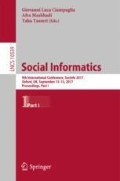Abstract
Depending on the reader, A news article may be viewed from many different perspectives, thus triggering different (and possibly contradicting) emotions. In this paper, we formulate a problem of predicting readers’ emotion distribution affected by a news article. Our approach analyzes affective annotations provided by readers of news articles taken from a non-English online news site. We create a new corpus from the annotated articles, and build a domain-specific emotion lexicon and word embedding features. We finally construct a multi-target regression model from a set of features extracted from online news articles. Our experiments show that by combining lexicon and word embedding features, our regression model is able to predict the emotion distribution with RMSE scores between 0.067 to 0.232 for each emotion category.
Access this chapter
Tax calculation will be finalised at checkout
Purchases are for personal use only
Notes
- 1.
- 2.
- 3.
- 4.
The website does not provide the number of votes but only the proportion of votes for the various emotions.
- 5.
- 6.
References
Abdaoui, A., Azé, J., Bringay, S., Grabar, N., Poncelet, P.: Expertise in French health forums. Health Inf. J. 1460458216682356 (2016)
Balahur, A., Steinberger, R., Kabadjov, M., Zavarella, V., Van Der Goot, E., Halkia, M., Pouliquen, B., Belyaeva, J.: Sentiment analysis in the news. arXiv preprint (2013). arXiv:1309.6202
Bandhakavi, A., Wiratunga, N., Massie, S., Padmanabhan, D.: Lexicon generation for emotion detection from text. IEEE Intell. Syst. 32(1), 102–108 (2017)
Bojanowski, P., Grave, E., Joulin, A., Mikolov, T.: Enriching word vectors with subword information. arXiv preprint (2016). arXiv:1607.04606
Cambria, E., Hussain, A.: Sentic Computing: Techniques, Tools, and Applications, vol. 2. Springer Science & Business Media, Netherlands (2012)
Cambria, E., Poria, S., Bajpai, R., Schuller, B.W.: Senticnet 4: a semantic resource for sentiment analysis based on conceptual primitives. In: COLING, pp. 2666–2677 (2016)
Hsieh, Y.L., Chang, Y.C., Chu, C.H., Hsu, W.L.: How do i look? Publicity mining from distributed keyword representation of socially infused news articles. In: Conference on Empirical Methods in Natural Language Processing, p. 74 (2016)
Lai, S., Liu, K., He, S., Zhao, J.: How to generate a good word embedding. IEEE Intell. Syst. 31(6), 5–14 (2016)
Lei, J., Rao, Y., Li, Q., Quan, X., Wenyin, L.: Towards building a social emotion detection system for online news. Future Gener. Comput. Syst. 37, 438–448 (2014)
Lin, K.H.Y., Chen, H.H.: Ranking reader emotions using pairwise loss minimization and emotional distribution regression. In: Proceedings of the Conference on Empirical Methods in Natural Language Processing, pp. 136–144. Association for Computational Linguistics (2008)
Lin, K.H.Y., Yang, C., Chen, H.H.: Emotion classification of online news articles from the reader’s perspective. In: 2008 IEEE/WIC/ACM International Conference on Web Intelligence and Intelligent Agent Technology, WI-IAT 2008, vol. 1, pp. 220–226. IEEE (2008)
Mikolov, T., Chen, K., Corrado, G., Dean, J.: Efficient estimation of word representations in vector space. arXiv preprint (2013). arXiv:1301.3781
Mohammad, S.M., Turney, P.D.: Crowdsourcing a word-emotion association lexicon. Comput. Intell. 29(3), 436–465 (2013)
Nam Nguyen, H., Van Le, T., Son Le, H., Vu Pham, T.: Domain specific sentiment dictionary for opinion mining of vietnamese text. In: Murty, M.N., He, X., Chillarige, R.R., Weng, P. (eds.) MIWAI 2014. LNCS, vol. 8875, pp. 136–148. Springer, Cham (2014). doi:10.1007/978-3-319-13365-2_13
Rao, Y., Lei, J., Wenyin, L., Li, Q., Chen, M.: Building emotional dictionary for sentiment analysis of online news. World Wide Web 17(4), 723–742 (2014)
Rehurek, R., Sojka, P.: Software framework for topic modelling with large corpora. In: Proceedings of the LREC 2010 Workshop on New Challenges for NLP Frameworks. Citeseer (2010)
Sahlgren, M., Cöster, R.: Using bag-of-concepts to improve the performance of support vector machines in text categorization. In: Proceedings of the 20th International Conference on Computational Linguistics, p. 487. Association for Computational Linguistics (2004)
Staiano, J., Guerini, M.: Depechemood: a lexicon for emotion analysis from crowd-annotated news. arXiv preprint (2014). arXiv:1405.1605
Strapparava, C., Mihalcea, R.: Semeval-2007 task 14: affective text. In: Proceedings of the 4th International Workshop on Semantic Evaluations, pp. 70–74. Association for Computational Linguistics (2007)
Strapparava, C., Valitutti, A., et al.: Wordnet affect: an affective extension of wordnet. In: LREC, vol. 4, pp. 1083–1086 (2004)
Zhang, Y., Su, L., Yang, Z., Zhao, X., Yuan, X.: Multi-label emotion tagging for online news by supervised topic model. In: Cheng, R., Cui, B., Zhang, Z., Cai, R., Xu, J. (eds.) APWeb 2015. LNCS, vol. 9313, pp. 67–79. Springer, Cham (2015). doi:10.1007/978-3-319-25255-1_6
Acknowledgments
This research is supported by the National Research Foundation, Prime Minister’s Office, Singapore under its International Research Centres in Singapore Funding Initiative, and PT Telekomunikasi Indonesia (Telkom).
Author information
Authors and Affiliations
Corresponding author
Editor information
Editors and Affiliations
Rights and permissions
Copyright information
© 2017 Springer International Publishing AG
About this paper
Cite this paper
Sulistya, A., Thung, F., Lo, D. (2017). Inferring Spread of Readers’ Emotion Affected by Online News. In: Ciampaglia, G., Mashhadi, A., Yasseri, T. (eds) Social Informatics. SocInfo 2017. Lecture Notes in Computer Science(), vol 10539. Springer, Cham. https://doi.org/10.1007/978-3-319-67217-5_26
Download citation
DOI: https://doi.org/10.1007/978-3-319-67217-5_26
Published:
Publisher Name: Springer, Cham
Print ISBN: 978-3-319-67216-8
Online ISBN: 978-3-319-67217-5
eBook Packages: Computer ScienceComputer Science (R0)

